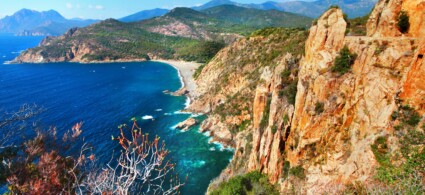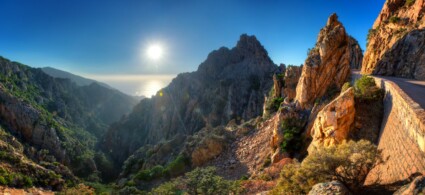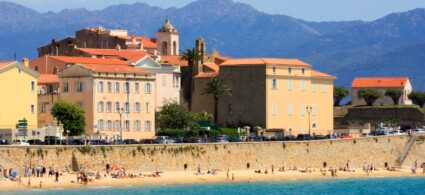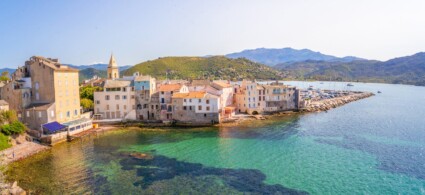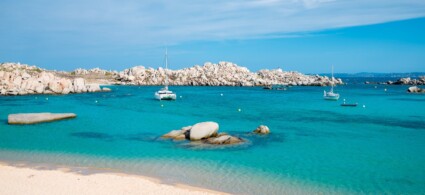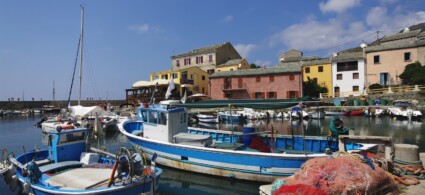

With its bursting colours, from the intense blue of the sea to the clear blue of the sky, the gold of the sunsets and the green of the Mediterranean maquis, Corsica will literally captivate you!
From the untamed cliffs of Bonifacio to the hidden bays of Cap Corse, from the marvellous fine sandy beaches of Calanques di Piana to the picturesque villages of Balagne, Corsica offers an incredible variety of breathtaking landscapes that will make your holiday in this romantic land unique.
The Corsican towns then show in all their splendour their historical matrix, with a markedly Genoese and maritime imprint. With a seaside vocation, they have managed over time to reconcile the signs of time and history with a unique and proud character that distinguishes the Corsican people. Although many tourists prefer to focus only on the sea, Corsica’s towns have always fascinated attentive and curious travellers.

Having become a sort of Corsican ‘capital’ thanks to a Napoleonic decree, Ajaccio retains a unique charm thanks to its palm-fringed waterfront, picturesque alleys and noteworthy museums.
Despite the chaotic traffic and the cumbersome presence of a perpetually active port, Ajaccio leaves its visitors with an indelible memory thanks also to the imposing and impregnable fortress that dominates the city, which remained closed to the public for a very long time.
Not to be missed is the citadel, which, surrounded by walls that have remained impenetrable for centuries, dominates the gulf.
Around Ajaccio, don’t miss the Scandola Nature Reserve, Cape Rosso and the Aitone Forests.
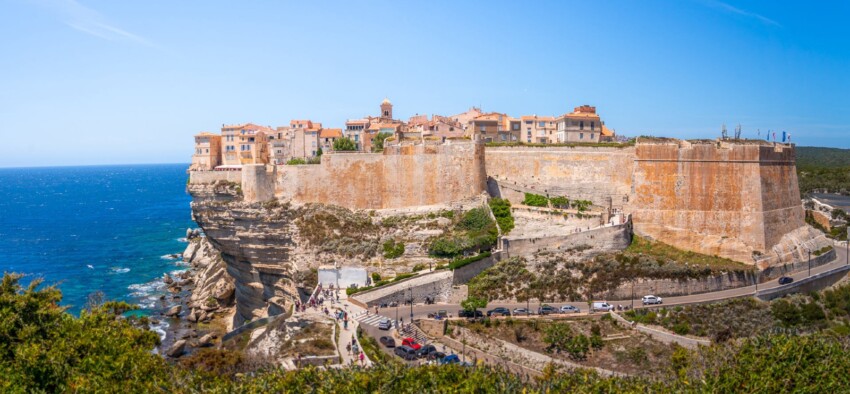
Bonifacio is one of the pearls of the island, a must-see destination on your trip to Corsica. A marvellous citadel with steep and narrow alleys built 70 metres above the white stone cliffs shaped by the wind and the sea, it dominates the turquoise waters of the Mouths of Bonifacio with its beauty and is surrounded by a series of magnificent beaches.
A picture that enchants the tourists who flock to the town in the summer months, often making it unlivable. Bonifacio is divided into two districts, the marine part at the end of the fjord and the old town perched on the cliff, the most characteristic part.
Around Bonifacio, don’t miss Sartene, with its dark stone houses, the tropical beaches of Rondinara, Palombaggia and Tra Licettu, the Lavezzi islands and the vital Porto-Vecchio.

Divided into three neighbourhoods, Place Saint-Nicolas, Terra Vecchia and the Citadel, Bastia is a city perched on a cliff and from above you can admire the incessant coming and going of ferries. Rich in Baroque churches and imbued with a magical folk and Mediterranean atmosphere, it will captivate you if you take the time to discover it.
The enchanting city of Bastia is the perfect postcard from Corsica. Old rose-coloured and scorched-earth buildings, winding alleys winding through the old town and the bustling harbour provide the best image of Bastia.
But this city is only the gateway to explore the magnificent surroundings, such as Cap Corse, the delightful little port of Centuri, the villages of Erbalunga and Nonza, the Caribbean beaches of Saleccia and Lodo and the secret coves of the Agriates coast.

An old Genoese stronghold, Calvi enchants visitors with its beautiful beach, rich cultural life and the picturesque alleyways of its citadel.
Don’t miss the Citadel, a district in its own right, raised on a rocky promontory, facing the sea and surrounded by ochre-coloured walls. Inside is a network of charming alleyways with arched passageways, open-air cafés, old historical buildings such as the Palais des Eveques de Sagone and the marvellous Cathedrale Saint-Jean-Battista with its magnificent carved dome.
For a day at the beach, you can head to Calvi beach, which is ideal for children thanks to its shallow waters, or you can take the coastal train that stops at the Balagne beaches.
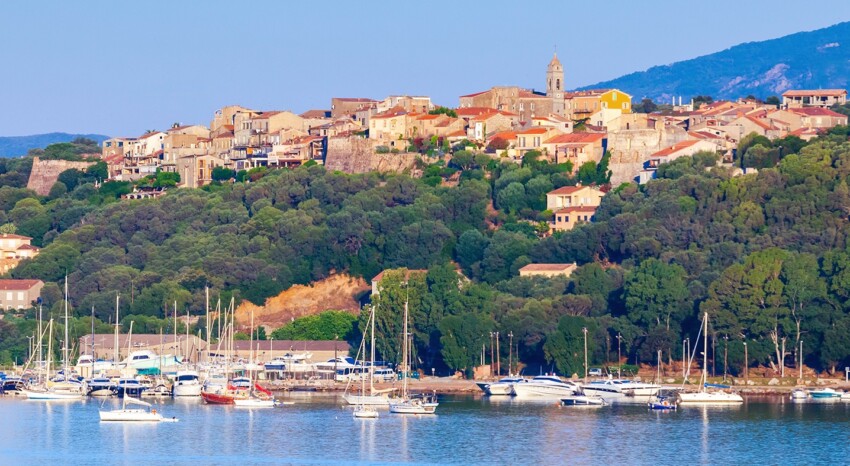
Porto Vecchio, Corsica’s third-largest city, has been able to preserve and conserve its marvellous historic centre intact despite unstoppable development. Of Genoese origin, it was reinforced several times after reclaiming the malaria-infested marshes: over time, it became a solid and charming town.
Surrounding the town are a series of magnificent beaches that have become holiday destinations for French and European celebrities.

Saint-Florent is a lively town with a harbour full of luxury yachts and fashionable clubs. The heart is the old citadel of Genoese origin, sandy in colour, so exotic that it could be mistaken for a Moroccan resort.
Don’t miss a relaxing walk through the narrow streets of the Citadel, lingering in the small squares packed with people and children playing around the fountains.
Saint Florent is also the starting point for boat excursions in the Agriates desert.

The delightful town of L’Ile-Rousse owes its name (red island) to the colour of the granite that makes up Ile de la Pietra, a small island connected to the town by a causeway. Ile-Rousse is famous for an enchanting beach right in the heart of the town (as well as for other remarkable beaches in the surroundings), for its gentle and peaceful atmosphere, for its shady little squares and promenade.
Exploring the narrow streets of the old town is a real treat.
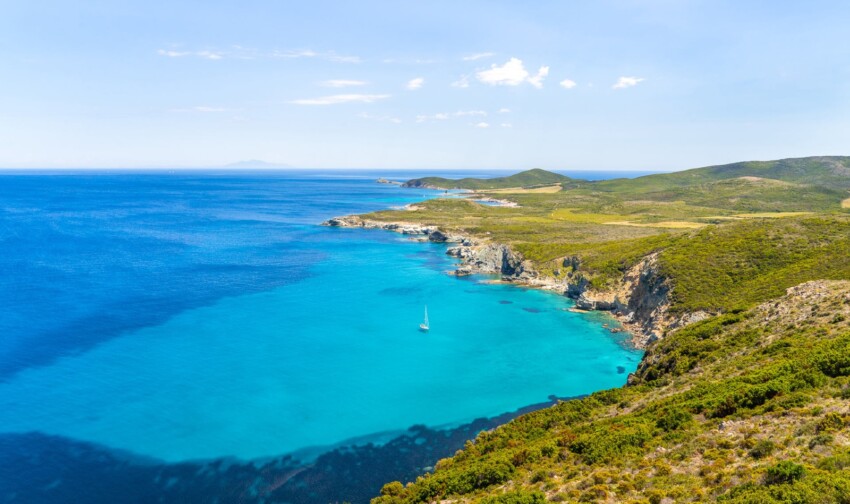
Cap Corse, a narrow peninsula in the north of Corsica, wedged into the sea just beyond Bastia. It is dotted with fishing ports and perched villages and criss-crossed by scenic roads that wind their way through spectacular landscapes, mountain passes and Genoese towers.
At the Cap Corse, the Sentiero dei Doganieri (not to be confused with the path of the same name in Brittany) is famous, linking the villages of Macinaggio and Centuri. It is a 19 km long path along the coast from which you can enjoy splendid views of the sea and cliffs. If you don’t feel like walking it all the way, know that the most interesting section is the one between Macinaggio and Barcaggio beach. The walk takes about 3.5 hours and crosses several spectacular beaches.
If you do not feel like walking or are short of time, you could take a cruise that will take you to discover both Capo Corso and the Finocchiarola and Barcaggio archipelago.
On the Cap Corse peninsula you should not miss the beautiful villages of Macinaggio, Barrettali, Canari, Nonza, Rogliano and Pietracorbara.
Finally, stop at Mattei Mill for a spectacular view of much of the Cap Corse.

The Scandola Nature Reserve is only accessible from the sea and its visit will remain indelibly in your memories for its magnificent beauty. Declared a Unesco World Heritage Site, it preserves a rich natural heritage of flora and fauna living in a complex system of caves and reddish faults, born of the volcanic origin of the area.
You can admire colonies of monk seals, ospreys, cormorants, algae, corals and fish.
The Gulf of Girolata is an absolutely marvellous spot, a stone’s throw from the Scandola Nature Reserve, accessible only by sea or on foot via a 3-hour round trip from Col de la Croix, called the Mari e Monti path: it will allow you to admire all the splendour of the gulf and the reserve without any difficulty.
Unfortunately, the bay of Girolata is very crowded in the summer months, due to the boats unloading hordes of tourists and crowding the sea basin, greatly spoiling the paradisiacal atmosphere of this marvellous corner.

The Lavezzi archipelago is a true corner of paradise, set in the sea and still little known to mass tourism. Its incredible beauty stems from the chromatic contrast between the turquoise and blue of its crystal-clear waters and the pastel shades of the granite rocks shaped by the wind and the sea. Don’t miss the opportunity to snorkel and admire these natural beauties!
Lavezzu Island is the largest island, inhabited only by the lighthouse keepers and boasting the clearest seabed and most enchanting scenery, while Cavallo Island is much more touristy and dotted with luxury villas.

The Agriates desert is located in the north of Corsica, between Ile-Rousse and Saint Florent. Mediterranean scrub and rocky conformations characterise the entire area.
Despite its name, the Agriates desert is famous for its beaches, which are among the most beautiful in Corsica. These include the beach of Saleccia, with its truly turquoise waters and surrounded by a pine forest, and the beach of Lotu.
The Agriates desert is also the only area of Corsica that is not crossed by coastal roads. As a matter of fact, all the beaches in this area, many of which are truly incredible, can only be reached along dirt roads or more simply by boat, perhaps from Saint Florent.
This is the ideal place if you are looking for untravelled beaches with an enchanting setting.

These bizarre rock formations are the pride of this stretch of coastline. Declared a Unesco World Heritage Site, the Calanchi di Piana are a veritable garden of stone, created by the erosion of wind and water, which penetrating into the ravines of the rock has hollowed out spherical cavities that are today smooth and magnificent.
The incessant work of erosion over the millennia has created bizarre and extravagant shapes that look like the silhouettes of plants and animals, like a kind of petrified people that leaves everyone breathless.
The best time to admire this wonder of nature is at sunset when the sun lights up the colours of the granite, providing an unforgettable spectacle. By car, you can follow the D81, a winding route to the calanques that winds its way through the jagged rocks – a true wonder!
If you like hiking, you can take numerous paths to explore the calanques on foot.

The enchanting landscape around Calvi is called Balagne, a fertile region with varied contours, ranging from mountainous reliefs full of picturesque villages to the languid beaches of the coast.
From Calvi, head to the village of Moncale (about 20 minutes) and you will find yourself at the starting point of the panoramic road that connects the most beautiful villages of Balagne. Don’t miss Calenzana, Zilia, Montemaggiore, Sant’Antonino, Pigna, Spelancato and Lumio.
Particularly noteworthy is the abandoned village of Occi, nestled between the mountains and the sea. In addition to the ruins of the village, there is a beautiful view of the bay of Calvi and Revellata from here. To access Occi on foot, you will have to pass through Lumio. It is a particularly suggestive place.
In the following map you can see the location of the main places of interest mentioned in this article.
